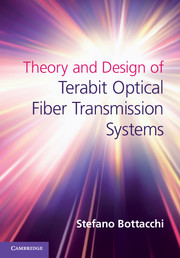Book contents
- Frontmatter
- Dedication
- Contents
- Preface
- Acknowledgments
- Part I Signals, spectra and optical modulations
- 1 Baseband signals and power spectra
- 2 Analytic signals and spectral efficiency
- 3 Optical signals, high-order modulations and spectra
- Part II Principles of light polarization and optical amplification
- Part III Interferometric optical modulators
- Part IV
- Appendix A Electromagnetic energy and power flow
- Appendix B Optical power and photon flux
- Index
- References
3 - Optical signals, high-order modulations and spectra
The average theorem of the complex exponential and its application to phase modulation
from Part I - Signals, spectra and optical modulations
Published online by Cambridge University Press: 05 September 2014
- Frontmatter
- Dedication
- Contents
- Preface
- Acknowledgments
- Part I Signals, spectra and optical modulations
- 1 Baseband signals and power spectra
- 2 Analytic signals and spectral efficiency
- 3 Optical signals, high-order modulations and spectra
- Part II Principles of light polarization and optical amplification
- Part III Interferometric optical modulators
- Part IV
- Appendix A Electromagnetic energy and power flow
- Appendix B Optical power and photon flux
- Index
- References
Summary
Introduction
In this chapter, we analyze amplitude modulation (AM) and phase modulation (PM) as the fundamental modulation formats to be used in optical as well as electrical communications to generate more complex and spectrally efficient modulation schemes.
Sections 3.2 and 3.3 review the analytical representations of the electromagnetic field, approaching the basic concepts of field phasor, polarization and monochromatic wave. The electromagnetic wave is characterized by the phasor and the carrier frequency. The modulus and the angular coordinate of the optical phasor specify respectively the amplitude and phase variation of the optical field. The modulation is named according to the way it changes either the modulus or the angular coordinate of the phasor. The spectrum of the modulated optical field is therefore a consequence of the AM or PM modulation scheme. As we will see in the following chapters, the widely used Mach–Zehnder optical modulator simultaneously changes both modulus and phase, providing a mixed form of optical modulation with characteristic phased paths in the complex plane.
- Type
- Chapter
- Information
- Theory and Design of Terabit Optical Fiber Transmission Systems , pp. 142 - 210Publisher: Cambridge University PressPrint publication year: 2014



